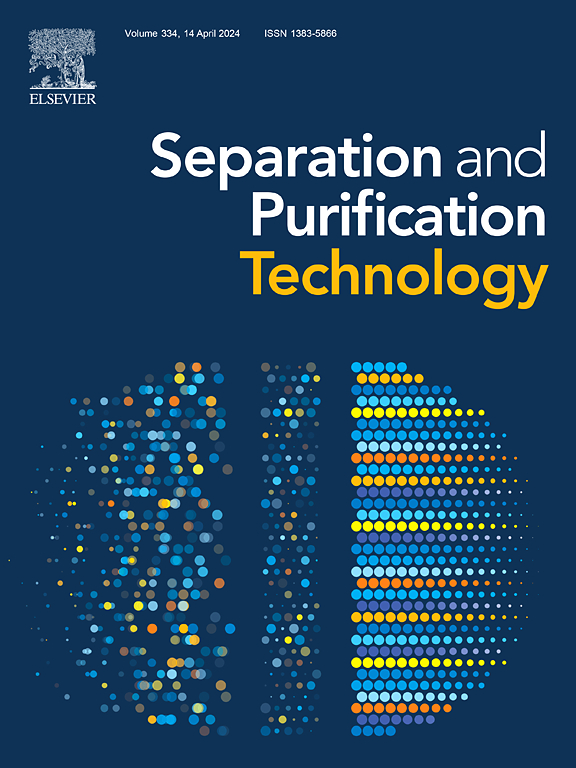Investigation of PFAS rejection by closed-circuit reverse osmosis and nanofiltration and sorption to treatment materials during groundwater treatment: a pilot demonstration
IF 8.1
1区 工程技术
Q1 ENGINEERING, CHEMICAL
引用次数: 0
Abstract
The rejection of a broad range of per- and polyfluoroalkyl substances (PFAS) by reverse osmosis (RO) and nanofiltration (NF) was evaluated using a pilot closed-circuit membrane system operating at three recoveries (80, 85, 90 %) treating aqueous film-forming foam (AFFF) impaired groundwater (total PFAS ∼ 14.3 µg/L). Evaluation of the membranes focused on 15 PFAS measured in the groundwater above 75 ng/L including carboxylates, sulfonates, fluorotelomer sulfonates, and sulfonamides, dominated by perfluorooctane sulfonate (PFOS).RO required higher pressures and energy to reach recovery setpoints than NF, in exchange for PFAS specific rejections greater than 99 %. Rejection by NF ranged from 97.9 to 99.8 % and was impacted by functional group (carboxylates > sulfonates, fluorotelomer sulfonates > sulfonamides) and increased by increasing chain lengths. Overall PFAS rejection by RO decreased between 85 and 90 % recovery, with discrete sampling demonstrating a decrease in rejection after 87 % recovery, indicating that the tradeoff between reduced retentate volume and decreased permeate quality is an important operational consideration.To evaluate PFAS sorption to treatment materials, methanol extractions were performed on pretreatment materials and one BW30 element. Adsorbed total PFAS mass was dominated by PFOS, with long-chain PFAS exhibiting preferential adsorption. Per gram of material extracted, a 0.2 µm cartridge filter accumulated the most PFAS. The membrane and IX softening resin had similar accumulation of PFAS, while accumulation was the lowest on greensand. PFAS chain length had the greatest impact on adsorption to the filter, membrane, and IX softening resin, sorption to greensand was more impacted by functional group.

在地下水处理过程中,闭路反渗透和纳滤对处理材料的吸附对PFAS的去除研究:中试示范
反渗透(RO)和纳滤(NF)对广泛的单氟烷基和多氟烷基物质(PFAS)的截除率进行了评估,使用中试闭路膜系统以三种回收率(80、85、90 %)处理水成膜泡沫(AFFF)受损的地下水(总PFAS ~ 14.3 µg/L)。对膜的评价重点是在地下水中测量到的15种全氟磺酸盐,含量高于75 ng/L,包括羧酸盐、磺酸盐、氟端聚体磺酸盐和磺酰胺,主要是全氟辛烷磺酸(PFOS)。RO需要比NF更高的压力和能量来达到恢复设定值,以换取PFAS特异性拒绝大于99% %。NF的拒收率为97.9%至99.8% %,受官能团(羧酸盐 >; 磺酸盐、氟端聚体磺酸盐 >; 磺酰胺)的影响,并随着链长的增加而增加。总体上,反渗透法截留PFAS的回收率在85%至90% %之间下降,离散采样表明,截留率在87% %之后下降,这表明在减少截留体积和降低渗透质量之间的权衡是一个重要的操作考虑因素。为了评价PFAS对处理材料的吸附效果,对预处理材料和一个BW30元素进行甲醇萃取。吸附总质量以全氟辛烷磺酸为主,长链全氟辛烷磺酸具有优先吸附作用。每克提取的材料中,0.2 µm滤筒累积的PFAS最多。膜和IX软化树脂的PFAS积累量相似,但绿化带的积累量最低。PFAS链长对过滤器、膜和IX软化树脂的吸附影响最大,对绿植的吸附影响最大,受官能团的影响更大。
本文章由计算机程序翻译,如有差异,请以英文原文为准。
求助全文
约1分钟内获得全文
求助全文
来源期刊

Separation and Purification Technology
工程技术-工程:化工
CiteScore
14.00
自引率
12.80%
发文量
2347
审稿时长
43 days
期刊介绍:
Separation and Purification Technology is a premier journal committed to sharing innovative methods for separation and purification in chemical and environmental engineering, encompassing both homogeneous solutions and heterogeneous mixtures. Our scope includes the separation and/or purification of liquids, vapors, and gases, as well as carbon capture and separation techniques. However, it's important to note that methods solely intended for analytical purposes are not within the scope of the journal. Additionally, disciplines such as soil science, polymer science, and metallurgy fall outside the purview of Separation and Purification Technology. Join us in advancing the field of separation and purification methods for sustainable solutions in chemical and environmental engineering.
 求助内容:
求助内容: 应助结果提醒方式:
应助结果提醒方式:


